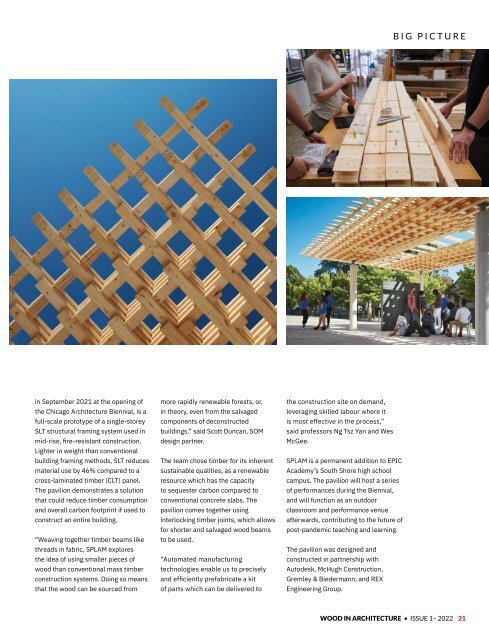Wood In Architecture Issue 1, 2022
First published in 2017, Wood in Architecture (WIA) is a bi-annual trade magazine devoted to the international timber construction sector. The newest addition to the Panels & Furniture Group of wood magazines, WIA features in-depth insights to the latest industry news, incredible projects and leading trade events. WIA is an advocate for timber as a material of choice for today’s built environment, and is the perfect source of inspiration for architects, builders, engineers and interior designers across the globe.
First published in 2017, Wood in Architecture (WIA) is a bi-annual trade magazine devoted to the international timber construction sector. The newest addition to the Panels & Furniture Group of wood magazines, WIA features in-depth insights to the latest industry news, incredible projects and leading trade events. WIA is an advocate for timber as a material of choice for today’s built environment, and is the perfect source of inspiration for architects, builders, engineers and interior designers across the globe.
Create successful ePaper yourself
Turn your PDF publications into a flip-book with our unique Google optimized e-Paper software.
BIG PICTURE<br />
in September 2021 at the opening of<br />
the Chicago <strong>Architecture</strong> Biennial, is a<br />
full-scale prototype of a single-storey<br />
SLT structural framing system used in<br />
mid-rise, fire-resistant construction.<br />
Lighter in weight than conventional<br />
building framing methods, SLT reduces<br />
material use by 46% compared to a<br />
cross-laminated timber (CLT) panel.<br />
The pavilion demonstrates a solution<br />
that could reduce timber consumption<br />
and overall carbon footprint if used to<br />
construct an entire building.<br />
“Weaving together timber beams like<br />
threads in fabric, SPLAM explores<br />
the idea of using smaller pieces of<br />
wood than conventional mass timber<br />
construction systems. Doing so means<br />
that the wood can be sourced from<br />
more rapidly renewable forests, or,<br />
in theory, even from the salvaged<br />
components of deconstructed<br />
buildings,” said Scott Duncan, SOM<br />
design partner.<br />
The team chose timber for its inherent<br />
sustainable qualities, as a renewable<br />
resource which has the capacity<br />
to sequester carbon compared to<br />
conventional concrete slabs. The<br />
pavilion comes together using<br />
interlocking timber joints, which allows<br />
for shorter and salvaged wood beams<br />
to be used.<br />
“Automated manufacturing<br />
technologies enable us to precisely<br />
and efficiently prefabricate a kit<br />
of parts which can be delivered to<br />
the construction site on demand,<br />
leveraging skilled labour where it<br />
is most effective in the process,”<br />
said professors Ng Tsz Yan and Wes<br />
McGee.<br />
SPLAM is a permanent addition to EPIC<br />
Academy’s South Shore high school<br />
campus. The pavilion will host a series<br />
of performances during the Biennial,<br />
and will function as an outdoor<br />
classroom and performance venue<br />
afterwards, contributing to the future of<br />
post-pandemic teaching and learning.<br />
The pavilion was designed and<br />
constructed in partnership with<br />
Autodesk, McHugh Construction,<br />
Gremley & Biedermann, and REX<br />
Engineering Group.<br />
WOOD IN ARCHITECTURE • ISSUE 1– <strong>2022</strong> 21


















